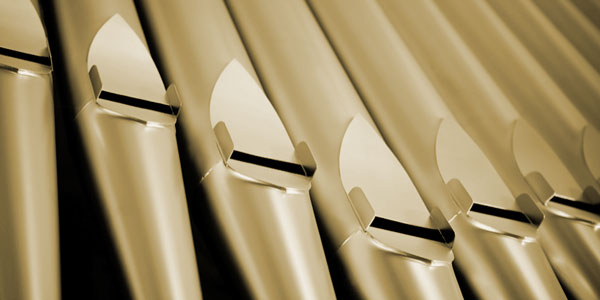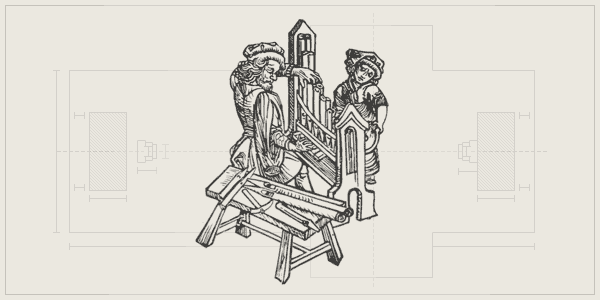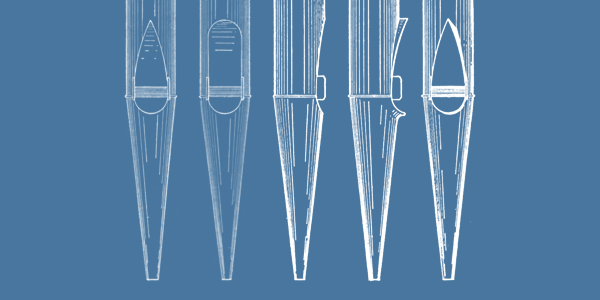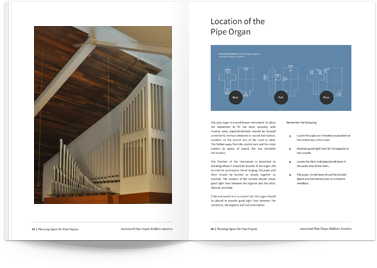Resources
We have produced several publications and collected relevant resources to provide a platform from which you can start your project.
Publications
Guide to Purchasing a Pipe Organ
What to keep in mind when starting your organ project.
Planning Space for Pipe Organs
Guidelines for planning and installation.
Fundraising for Organs
Organize and implement an effective fundraising plan.
Videos
APOBA Introduction Video
We are APOBA
How To Buy a Pipe Organ
Pipe Organ Costs and Benefits
Frequently Asked Questions
Below are some common questions our clients have when purchasing an organ. The member firms stand ready to answer specific questions, so please contact us if your question is not listed here.
As a general rule of thumb, a pipe organ is tuned twice a year, either at the change of seasons from hot to cold, and cold to hot, or before Easter and before Christmas. The cost of this biannual tuning will vary depending on the size of the pipe organ and area in which the pipe organ is located. In general, tuning and maintenance will require roughly one hour for every six stop in the organ. Hourly rates will vary from $85.00 per hour to $125.00 per hour.
The weight of a pipe organ is dependent on its size, how many stop it has. A good rule of thumb for determining weight is 750 lbs per stop.
The size of a pipe organ is always described in terms of stops. A stop is one set of pipes that goes from the bottom of the keyboard to the top of the keyboard. While there is no hard and fast rule regarding size of pipe organs, a good method for determining an appropriate range of size for your church is 5 – 10 stops for every 100 people of seating capacity. If your church seats 100 then you should consider an organ of 5 – 10 stops. If your church seats 500, then you can consider an organ of 25 – 50 stops.
The primary mechanical and sound producing components of a pipe organ are wood and leather for the frame and chests and casework, and zinc, lead and tin for the pipes. The wood and metal parts will last for centuries. The leather parts need to be replaced approximately every 60 years. This leather replacement is always a fraction of the original cost of the instrument.
The cost of a pipe organ can be as low as $30,000.00 for a used instrument relocated to a new home, to millions of dollars for a new instrument built for a major church or concert hall. The range of cost for a pipe organ for a small to medium-sized church is in the area of $200,000.00 – $850,000.00.
Occasionally, a church needs to sell their organ. Our initial advice: if you have the space, keep the organ. Even if you don’t have immediate plans to use, restore or maintain the organ, someday, your congregation may want the pipe organ returned. It’s ability to inspire cannot be replaced by electronically produced sounds through speakers, nor will guitars and drums have a lasting place in traditional church worship. Further, the escalating costs of manufacturing a new organ will play a role in future decisions; good stewardship dictates that the investment made by those who have preceded you be carefully weighed.
That said, your first challenge will be to place a value on the instrument. This is often difficult given the wide range of manufacturers, sizes, tonal designs, locations (installation complexity) and intricacy of the action. You will need to understand the differences between market values, insurance (replacement) values and depreciated values. You will need to understand the perspective of the purchaser who will need to consider the associated costs involved with redesigning, reconfiguring, revoicing an organ that was custom designed for your congregation, your physical space and your acoustic. In short, you will need an organbuilder for step one. Hopefully your current service provider can help; certainly, an APOBA member can help.
Step 2: Consider the avenues available to advertising and selling the organ. We suggest using the Web to contact the Church Organ Trader. These folks advertise any and all things related to pipe organs. We also suggest using classified ads in both The American Organist and Diapason magazines; also accessible on the web.
Step 3: Depending on the conditions of the present organ’s installation, you may wish to consider hiring an insured professional to remove the organ in order to protect the building and its furnishings, as well as anyone who might be injured in the process. Please feel free to include a summary of your situation in the Message section on the APOBA Contact page and check with your local APOBA builder for advice. There may be a small consultation fee involved, but it is imperative that an organ be properly removed for preservation. Occasionally an organ is removed in exchange for the cost of removal; this ensures its preservation and prevents the harmful portions of the organ (lead and tin) from being improperly disposed.
The pipes in a pipe organ are designed and labeled by two different primary factors. First is its pitch. The different stops in a pipe organ always have a number in front of them. This number refers to the speaking length of the stop. If the number is 8’, then the stop speaks the same pitch as you will hear on a piano. If the number is 16’ then the stop will speak the pitch one octave lower than the pitch on a piano. If it says 4’, it will speak the pitch one octave above the same pitch on the piano. And so on and so forth all the way down to 64’, and all the way up to 2 2/3’, 2’. 1,3/5’, 1 1/3’, 1’ and beyond.
Second is timber or color of sound. Directly following the pitch number will be a name. The name refers to the color of sound for the particular stop. In general, the colors of sound fall into two different categories. They are flue pipes and reed pipes. Flue pipes make their sound in the same way as a recorder or penny whistle. The pressurized air goes in one end of the pipe (the foot), is channeled through a small slot (the windway), and strikes a thin lip a certain distance above the small slot (the upper lip). This process starts the column of air in the body of the pipe vibrating at its given speed and producing its given pitch. Flue pips are generally subdivided into two groups, those in which the bodies are open on top (Principals and Strings), and those which are stopped on top (Flutes).
Reed pipes make their sound in the same way as a clarinet or saxophone. The pressurized air goes in the bottom of the pipe (the boot). It passes between a brass reed and brass shallot (similar to the mouthpiece and reed on a clarinet). This process starts the column of air in the resonator of the pipe vibrating at its given speed and producing its given pitch. Reed pipes are generally subdivided into two groups, those with conical resonators (Trumpet and Oboe type stops) and cylindrical resonators (Cromorne and Clarinet type stops).
There are three different systems for playing the pipes in a pipe organ. Each system is also known as type of ‘key action’. The first key action is mechanical action, also known as tracker action. In this system, there is a direct mechanical connection between the keys at the console (the place where the organist sits) and the valve for each note. The second is electropneumatic. In this key action there is an electrical connection between the keys at the console and the valves for each note. The valves for each note are a combination of small electrical magnet and a series of two pneumatic valves, thus the name, electro pneumatic. Last is direct electro-mechanical. In the electro-mechanical action there is an electrical connection between the keys at the console and a single electrical valve under each pipe. It is not uncommon for these key actions to be used in combination with each other.
Fundraising for a pipe organ project is different for every church or other institution. In some instances, every member of a congregation gives what they can. In others, the entire cost of the project is given by one person. A third, fairly common approach is to raise one third to one half of the project cost from large donors before presenting the project to the congregation for further fundraising.
The first step in any organ project is forming an organ committee. A pipe organ is a significant addition to any church. The organ should be purchased not only for the organist, but because of the way in which it will enhance the worship life of the church. The committee should be a fairly diverse group which reflects the character of the church membership. Once the committee is formed, they need to begin the process of self-education. A pipe organ is a very diverse and complex musical instrument. Because of its diversity and complexity, education is essential for the committee to make an informed decision. Part of this education should include traveling to hear different pipe organs, and talking to different pipe organ builders. Following these visits and interviews it is customary for the committee to choose limited number of builders to present proposals to the committee. These proposals are then evaluated and a single builder chosen to proceed with the project.








